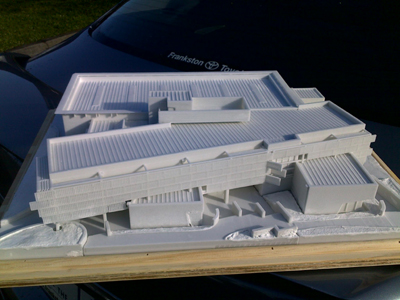3D Printing
3D Printing - Teaching Students the Latest Technology for Future Benefits in Architectural, Art and Design Industries
The Chisholm Institute of TAFE, in Frankston in Melbourne has embarked an ambitious programme to teach students in the Advanced Diploma - Building Design, best practice techniques and how to use the latest generation in 3D printing technologies to enhance their studies and to ensure that when they enter the workforce that their skills and knowledge of this innovative approach to model-making, will be of positive benefit to future employers.
Rodger Carroll, Building and Furniture department manager at Chisholm believes that Chisholm's purchase of a ZPrinter 650 3D printer for the Institute from Hi-Tech Metrology, has already achieved two significant goals since its purchase in May 2010. The first of these has been to provide an opportunity to enhance the skill sets of students in the art & design, product design and architectural streams in the latest generation of 3D printing systems; as well as to develop the capabilities to be able to provide 3D printed models to commercial clients in the architectural and design arenas, in order to help off-set some of the running costs of the machine such as consumables.
In developing techniques for using the ZPrinter 650 3D printing system for architectural applications the group at Chisholm has discovered the importance of reviewing 3D designs - before the printing process takes place as structural elements such as posts and supports become "unprintably small" when printing a 1:100 scale model, and these elements need to be thickened or increased in size so that they can be successfully printed. Other techniques such as designing in true 3D are also important when models are to be printed from 3D CAD files to ensure that they are "water-tight" and that there are proper support structures for multiple storey models or pipe hangers for pipe runs for example, in plant and equipment and process industry models.
A recent art design project for a local client required Chisholm to produce a model of a baby monkey 's face and a print of a mask of a full-grown monkey in exceptional detail and resolution. To the client's delight the models exceeded their expectations in terms of detail and turnaround time and now the 3D printer is seen very much as a core technology for artists and design students alike to use internally for a growing number of new and exciting art projects within the Institute.
Some of the issues with the linking of the various commercially-available software products that are available in the architecture area in particular have presented some challenges for Chisholm, but they have in the main overcome most of these difficulties and in fact have produced a 6-piece architectural model of a large commercial building for a commercial client in Dandenong in Victoria using a 2D CAD model in standard AutoCAD software and using the ZEdit PRO software supplied with the ZPrinter 650 have been able to project vertically the walls and other vertical features of the building in order to produce a full 3D building model.
Chisholm are already talking to a number of other clients about using 3D printing techniques to help them to present to their clients ways of visualizing a new home or how the client's new house will sit and their block and also for planning purposes, in conjunction with additional site scanning techniques, to show overlays and shadowing effects of future developments etc. A new home builder in Melbourne is also taking to Chisholm about using 3D models of their new home designs for marketing purposes and to show potential clients what their new homes designs look like - in full colour and in 3D to scale, particularly when display homes are not available for all the homes in their range. Full 3D models of new homes are a more favoured way of presenting to clients a visualization of their new home over web-based "artist impressions" and walk-throughs etc.
The use of the technology and strong adaption processes by Chisholm is very impressive, particularly with the addition of render, to make the models more lifelike and realistic. A good example of these particular skills and application of the technology has been to take photographs of the sky in order to add reflections to items such as solar panels and windows and other glass panels in their designs. Models with these enhancements are more realistic and add an extra dimension to the marketing benefits that this technology brings to the architectural market in particular.
The future for the 3D Printing program at Chisholm, a far as Rodger Carroll is concerned is very clear and their commitments include: more 3D Printing involvement in product design syllabus, replacing older style technologies such as "profiling machines" in their engineering courses, involving secondary school students in the printing of simple product design models, and generally involve all students in technology that they will use in the future in their professional careers.
